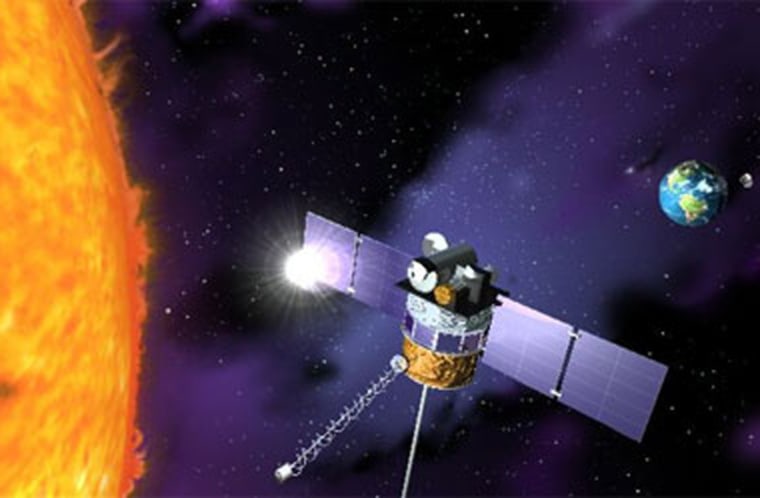NASA's Deep Space Climate Observatory was designed to monitor Earth from the vantage point of distant space. It was to be the first probe to give scientists a holistic, global view of temperatures and environmental conditions.
Originally named Triana, it became a poster child for then-Vice President Al Gore, who thought it would be a good idea for NASA to put a TV camera on the spacecraft so it could broadcast live views of Earth from the vantage point of deep space as a constant reminder that we share one world.
Politics outmatched science, however, and when the Bush Administration took office in 2001, it killed the program, sending Triana into deep storage rather than deep space.
After sitting in a box at the Goddard Space Flight Center in Maryland for eight years, the observatory is now on the brink of resurrection.
Last year, NOAA asked NASA to check out the probe to see if it could serve as a sentry for solar storms. From its vantage point about 1 million miles from Earth, the observatory would have about an hour's advance notice of potentially dangerous storms that could knock out radio communications, disrupt power grids and damage satellites with blasts of radioactive particles.
Now a second effort, funded by Congress, is under way which could restore the original intent of the mission. Lead scientist Francisco Valero, now 73, pitched the program to NASA officials last week.
"This satellite represents a new way of thinking," Valero, a scientist with Scripps Institution of Oceanography in San Diego, told Discovery News. "We have been for decades using an approach in Earth observation in low-Earth orbit. It has provided incredibly valuable data. Now that time has come to introduce a new approach to extend the knowledge we have acquired."
Valero likens the deep-space view of Earth to looking at the proverbial forest, while keeping an eye on the trees. "You can follow global warming continuously during the day, from sunrise to sunset," he said.
The observatory is designed to operate in an orbit known as the L1, the first of five Lagrangian points where small objects can remain relatively fixed in position, balanced by the gravity of the Earth and the moon. L1 is roughly four times farther from Earth than the moon.
After completing the NOAA work to test the observatory's solar instruments, NASA is now finishing an assignment from Congress to test its Earth science instruments and outline options for a new mission, said NASA spokesman Stephen Cole.
"The testing has concluded," Cole told Discovery News. "I don't have a firm date of when the report will go to Congress."
Cole said NASA already has spent $97 million on the program, though Valero puts that figure closer to $250 million.
Deep Space Climate Observatory was assembled and was part way through testing when the program was canceled in November 2001, about a year from its planned launch.
Valero would like to update the probe's computer and eight-megapixel camera. But its mirror and prime instrument — a heat-sensing radiometer to make the first direct measurements of how much sunlight is reflected and emitted from the whole planet — remains state-of-the-art, he said.
"Were it not for my hope that this will fly, I'd go and play with my grandchildren, which is wonderful," Valero said. "This is a very significant program. It is the next step. It will either happen now, or in the next 10 years. I hope it is soon."
